
Solvent Reservoir Filters from Agilent
Agilent provides a range of solvent filters for use with a variety of LC applications and equipment. Glass filters and solvent inlets with 20 µm pore sizes can be utilized for analytical scale and micro scale LC and a 40 µm pore size for preparative LC or dual loop autosamplers. Stainless steel solvent inlet filters are also available for use in capillary and nano systems.
All solvent filters and frit adapters are manufactured to Agilent's high levels of quality and security.
Solvent Filters
Solvent inlet filters represent the first barrier for retaining particulates, precipitation, microbes from mobile phases, buffers, and salt solutions. Filters are significant in preventing system blockage, pressure increase, and contamination. Cleanliness of parts is vital for avoiding system contamination. Agilent solvent filters are packed in ultraclean antistatic bags with an inner metallic coating that does not release contaminants such as plasticizers or antioxidants. LC/MS analysis shows that filters not from Agilent, packed in normal plastic packs, can cause extra peaks during analysis. Erucamide, a common slip agent used in polyethylene films, is one such example.
Pore size
A good solvent glass filter should have a defined, homogenous pore size to effectively block particulates above a certain size, while letting mobile phases through without significant pressure increase. Too large pore size leads to deficiency of filtration, while pores that are too small can cause pressure increase, resulting in solvent pumping difficulties. Inspection of Agilent and other vendor solvent glass filters by scanning electron microscopy (SEM) shows uniform pore sizes and smooth particle surfaces in the Agilent filter. In contrast, other vendor filters had inconsistent particle and pore sizes. The small particles or particle fragments shown on the other vendor filter could be flushed into the flow path, blocking the pump frit, capillaries, valves, or columns.
Cleaning the Solvent Filter
If the filter is in good condition, the solvent will freely drip out of the solvent tube (hydrostatic pressure). If the solvent filter is partially blocked, only very little solvent will drip out of the solvent tube. Caution: Small particles can permanently block the capillaries and valves of the module.
- Always filter solvents
- Never use the module without solvent inlet filter
| Description | Recommended Use | Part Number | Frit Adapter | Part Number | Frit Inlet ID (mm) | Tube OD (mm) |
| Glass filter, solvent inlet, 20 µm pore size | Analytical scale, micro scale | 5041-2168 | Frit adapter, PTFE, 3 mm, 4/pk | 5062-8517 | 5 | 3.2 |
| Stainless steel filter, solvent inlet, 10 µm pore size | For use in capillary and nano systems | 01018-60025 | No adapter required, filter goes directly into 1.5 mm id tubing | |||
| Glass filter, solvent inlet, 40 µm pore size | Preparative LC | 3150-0944 | Frit adapter, PTFE, for 4.7 mm od tubing | G1361-23205 | 7 | 4.7 |
| Glass filter, solvent inlet, 40 µm pore size | Preparative LC | 3150-0944 | Frit adapter, PTFE, 4 mm | G1361-23204 | 7 | 4 |
| Glass filter, solvent inlet, 40 µm pore size | For G2258A dual loop autosampler | 3150-0944 | Frit adapter, PTFE, for 3.2 mm od tubing | G2258-23201 | 7 | 3.2 |

